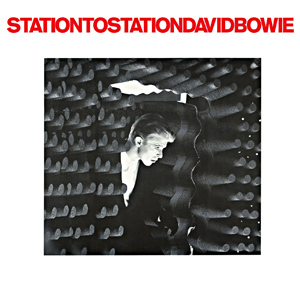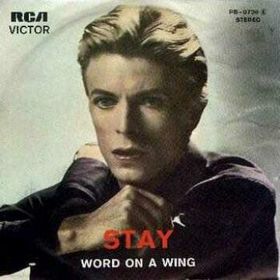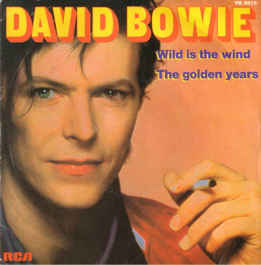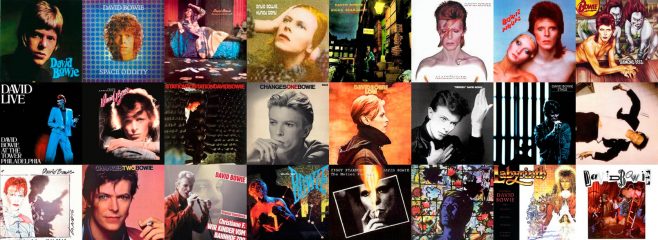
“Station To Station” is David Bowie’s 10th studio album, originally released on 23rd January 1976.
In 1975, David Bowie was in a very very dark place. Located in the decadent, pressure-cooker metropolis that was Los Angeles, Bowie was desperately struggling to cope with the fame and stardom he had spent so many years striving to achieve. With access to precious few true friends, a marriage that was rapidly disintegrating, a deteriorating relationship with his manger Tony Defries who was ripping him off, Bowie had little positive influences when the wicked temptations that LA had in abundance came calling.
Living on a diet supposedly consisting only of milk, peppers and vast amounts of cocaine (which doesn’t quite cover all the necessary food groups), Bowie became sickly thin and gaunt.
Bowie’s isolation, loneliness and rising paranoia had a frightening impact on his mental health, with bizarre tales of his dabbling with the occult quickly becoming an obsession. It’s one thing to write about the “Golden Dawn” and Aleister Crowley but quite another to store your urine in a fridge for fear it being stolen by evil beings and use for wicked spells.
In this fragile, broken state, Bowie decided to record a new album as a follow-up to his hugely successful (especially in the US) “Young Americans” album and No. 1 US hit “Fame“. Bowie’s record company RCA were keen to reproduce the commercial success of the previous album, so in you go my boy and record another hit please. That he managed to record anything listenable in his current state is an achievement in itself. That he managed to record a masterpiece is nothing short of astonishing.
His producer of choice Tony Visconti wasn’t available, so he knocked on the door again of famed producer Harry Maslin, who had worked with Bowie on the final recordings that made it onto the “Young Americans” album, including the classic song “Fame”.
As his rhythm section, he chose again those primarily from these final “Young American” sessions, Dennis Davis on drums, Carlos Alomar on rhythm guitar and Bowie newbie George Murray on bass. These three known collectively as the D.A.M. Trio would go on to work together with Bowie all the way through the rest of the 70s to the “Scary Monsters and Super Creeps” album.
On lead guitar, he also retained the young Earl Slick, who would feature again during the “Serious Moonlight” tour in 1983 and through much of the later period of Bowie’s career.
Bowie had been an enthusiastic Bruce Springsteen fan for much of his career, even recording a number of Springsteen covers in previous years. The final additional to the session musicians was the rather excellent Roy Bittan from the E-Street Band on keyboards.
Recorded at the Cherokee Studios in LA during some frantic sessions between Sept-Nov 1975, Bowie was later to state he had absolutely no recollection of the recording sessions at all. In fact Bowie found most of 1975 and much of 1976 all a little vague…
The album opens with the epic title track “Station To Station“. Starting with the ever faster chugging of a train moving between speakers, each instrument makes an appearance before the catchy opening rhythm breaks in, with Slicks guitar snarling away in the background. Finally after a few minutes, Bowie’s vocals makes its appearance, introducing us to his new character, the cold, menacing “Thin White Duke” who is “Throwing darts in lovers’ eyes“. Bowie described him as someone living in the US desperate to return back to Europe (no clue then who that could be).
Despite the train sound effects, lyrically “Station To Station” refers more to the stations of the cross, with the key line “Here are we, one magical movement from Kether to Malkuth” referring to the Jewish Sephirots in the Tree of Life (Crown to Kingdom). It’s all heavy stuff for a rock song…
The song then effortlessly jumps into its second, faster tempo, soaring middle section where Bowie sings about his frantic need to search, for fortune, for answers and above all for love. To say Bowie sounds absolutely magnificent here would be an understatement.
As quickly as it arrived, the middle section ends and we enter the third section of the track, where things speed up even more and we hit the killer lines “It’s not the side-effects of the cocaine, I’m thinking that it must be love, It’s too late to be grateful“. The vocal now becomes almost frantic while the music simply pulses with energy as Bowie proclaims “The European cannon is here“. A wonderful guitar solo by Slick gives Bowie a break before coming back to repeat things again as if to say he really means it all. The track then slowly fades with the band chugging away as if on the back of a train as it disappears into the distance.
It’s one of the most exhilarating, extraordinary 10 minutes Bowie has ever put down on tape.
Before you can catch your breath, the incredibly catchy funky riff of “Golden Years” kicks in. One of Bowie’s great singles, it perfectly spans the plastic soul disco of “Young Americans” with the more calculating funk rock of the new album. Apparently a song written for Bowie’s wife Angie Bowie, it’s just a perfect pop song that can fill a dance floor today as it did 40+ years ago. The whistling section near the end is just divine, although the much longer album version keeps the riff going and going and going. The song was slated as being offered to Elvis who (thankfully) rejected it. The lead-off single, it kept Bowie up in the charts reaching a respectable No. 10 on the US singles chart. There was no official video made of the single, although Bowie’s somewhat imperfect lip-sync performance of the song on the US “Soul Train” TV show serves as the unofficial visual document. Watch it here.

We then reach the end of side one with the beautiful, angelic “Word On A Wing“. More desperate prayer than song, this comes across as Bowie pleading with God for help and answers to life “Lord, I kneel and offer you, My word on a wing, And I’m trying hard to fit among, Your scheme of things“. The music is still catchy but more gentle and subdued than the rest of the album, with Bittan’s piano more predominant in the mix. Bowie’s vocals are just stunning, as they are throughout the album. But I’m not sure he has sounded quite as vulnerable as he does here, which gives the track an added edge.
Side two starts with the bizarre joy that is “TVC 15“. Basically about a TV that physically consumes his girlfriend, it’s based on a drug-fuelled hallucination that Bowie friend and fellow drug-troubled Iggy Pop had one evening. It’s a fabulous catchy track, with the band in fine form, especially Bittan who’s piano again dominates. The “Transition, Transmission” section is a delight before the wondrous chorus with the TVC 15 chant. The full length album version has a final chorus that goes on and on which is fine as I never really want this to finish. Released as the second single off the album, the strange subject matter was possibly not for everyone and didn’t fare anywhere near as well as the last few singles, only managing a disappointing No. 64 in the US (and just No. 34 in the UK). Not sure having the “Diamond Dogs” track “We Are The Dead” was the best of B-Side selections. Anyways, I don’t really care as I simply love this song.

“Stay” is a slab of classic 70’s era funk, with Earl Slick and his wonderful guitar riff in particular shining out here. Bowie’s vocal is as desperate and moving as ever, this time pleading for a loved one to just please stay. If I had to pick the weakest track, this would be it, but it’s all relative as this can get my feet tapping as any classic Bowie track can. Released in the US only as a single, it failed to chart.

The album ends with the stunning “Wild Is The Wind“, a cover of the Johnny Mathis song from the 1957 movie “Wild Is The Wind“, although the 1966 version by Nina Simone was the better known. Bowie often includes a cover on his albums, but I figure this to be the best cover version Bowie has ever recorded. I also rate this probably Bowie’s finest vocal performance. So high praise indeed, but what a magical way to end the album. The arrangements here are just gorgeous, with Bowie on acoustic guitar a highlight. But the way he hits that final note, just wow. An edited version was released as a single way later in 1981 to promote the non-essential “Changestwobowie” compilation album. It reached a respectable No. 24 on the UK charts considering it’s a song from 5 years ago. Watch the video here, filmed at the same time as the videos for the Baal EP.

The album was critically acclaimed at the time and a top 10 commercial success throughout the world, reaching No. 5 in the UK and No. 3 in the US. My main complaint with the album has always been that it’s too short, with just the 6 (albeit lengthy) tracks. At a touch under 38 minutes, it’s the shortest studio album that Bowie recorded. I know, I’m just greedy…
Bowie toured the album with the hugely successful “Isolar” World Tour, covering North America and Europe between February and May 1976. With swept back orange hair, dressed in white shirt and black waistcoat and with a packet of Gauloises cigarettes in pocket, Bowie played the part of the Thin White Duke with cool detachment. Bowie would later call the Thin White Duke as the least appealing and unlikable of all his characters. Rather than the usual big set and bright coloured lights, the stage was basic, minimalist with just white lights flooding the stage. The live band was similar to those of the studio sessions, but with Stacy Heydon replacing Slick and Tony Kaye replacing Bittan.
There have been a number of re-releases of the album over the years, including the always excellent Rykodisc CD series released in 1997. This featured (I think) the superior coloured cover rather than the standard black and white still image from the 1975 movie “The Man Who Fell To Earth” that starred Bowie.

However the best re-release was the “Station To Station” Box Set released in 2010. Containing lots of goodies including an original analogue master, an 1985 RCA Master version, a CD of single-edits of tracks and physical record, the two big highlights were a wonderful DVD of a 5.1 surround sound re-mix of the album and a new stereo remix both by Harry Maslin and both CD/LP versions of the “Live Nassau Coliseum ’76” album, recorded in New York on 23 March 1976.
The new Harry Maslin stereo remix was also available on the excellent “Who Can I Be Now” box set released in September 2016, that covers Bowie’s output between 1974-1976. Although it’s always nice to hear a fresh interpretation of the album, I prefer the original mix, especially in relation to how Bowie’s vocals are captured, finding the new mix adds too much reverb and unnecessary effects.

The 1976 tour is one of Bowie’s most critically acclaimed, with the “Live Nassau Coliseum ’76” album (for many years a much valued bootleg) a fantastic document of the tour. Bowie was in fine form, with the Station To Station tracks along with gems such as “Waiting For The Man”, “Panic In Detroit” and “Rebel Rebel” performance highlights.
The live album was eventually released separately in 2017.
The 5.1 remixes are also just brilliant and bring a totally new dimension to the whole album. Sitting in a living room, with Station To Station reverberating all around you is a wonderful experience. Highly recommended.

“Station To Station” is a truly sensational album that serves as the perfect bridge between the disco oriented commercial monster that was “Young Americans” to the more experimental electronic adventurism of the upcoming Berlin Trilogy. Listening to the album today, it just doesn’t come across as music that was created over 40 years ago.
After the tour, Bowie decided to escape the excesses and temptations of LA and move permanently to Europe for a quieter, saner existence, to clean himself up and basically save his life. That he chose to eventually move to Berlin with Iggy Pop made the recovery process a touch more “complicated”.
With the same rhythm D.A.M Trio, Bowie moved on to complete the hugely influential Berlin Trilogy of albums before recording what some (not me) consider to be his last masterpiece, “Scary Monsters and Super Creeps“. But that’s a story for another day.
Best Tracks: “Station To Station“, “Golden Years“, “Wild Is The Wind“
